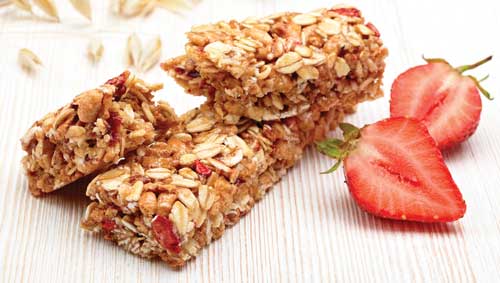The Many Facets of Fiber Fortification
NUTRACEUTICALS
 Dietary fiber boasts documented benefits for weight management, heart health, immunity, satiety, and digestive health. “Fifty-six percent of U.S. adult consumers are seeking more dietary fiber,” says Pam Stauffer, global marketing manager at Cargill Inc., Minneapolis, Minn. (www.cargill.com). “Most often, consumers associate digestive health benefits with fiber. While they may not always be able to fully articulate why fiber is important, most consumers feel they don’t get enough in their diets.”
Dietary fiber boasts documented benefits for weight management, heart health, immunity, satiety, and digestive health. “Fifty-six percent of U.S. adult consumers are seeking more dietary fiber,” says Pam Stauffer, global marketing manager at Cargill Inc., Minneapolis, Minn. (www.cargill.com). “Most often, consumers associate digestive health benefits with fiber. While they may not always be able to fully articulate why fiber is important, most consumers feel they don’t get enough in their diets.”
Today’s dietary fiber recommendations are 25 g/day for adult women and 38 g/day for adult men. Average intake of dietary fiber, however, is estimated to be only 15 g/day. Whole foods like vegetables, nuts, whole grains, and legumes are sources of dietary fiber. In addition,ingredient suppliers are offering various types of fiber ingredients that can help boost the content of commonly consumed foods and beverages. These ingredients also add the reported digestive, satiety, immune, and heart health benefits.
Polydextrose
Polydextrose is a highly branched polymer of glucose, which is recognized as a soluble fiber. “Litesse® polydextrose has a unique arrangement of glycosidic linkages, making it resistant to hydrolysis by human digestive enzymes; therefore, following ingestion, it passes intact into the colon where it is partially fermented by the colonic microflora,” explains Ramón Espinoza, product specialist, active nutrition, at DuPont Nutrition & Health, New Century, Kan. (www.dupont.com). “In this way, Litesse contributes an energy value of just one calorie per gram.”
In the last several years, research has focused on the benefit of Litesse in weight management and satiety. “Over the past 10 years, the program of research resulted in the publication of five human studies,” says Espinoza. “These studies consistently demonstrate the ability of Litesse polydextrose to reduce voluntary energy intake at a subsequent meal. These studies also indicate that this reduction in energy intake is not compensated [for] during the rest of the day. The studies established that a dose of just 6.25 g/serving is required to achieve these effects.” Further, the most recent human studies have also found that Litesse can suppress the desire to eat immediately after ingestion, reduce hunger between meals, and regulate appetite hormones.
Soluble Corn Fiber
Holscher et al. (2014) examined the effect of soluble corn fiber and polydextrose on the functional capabilities of the bacteria in the gut. Kelly Swanson, a professor of nutrition at the University of Illinois at Urbana-Champaign, and his research team had previously been able to see a “snapshot” of which bacteria were present in the gut after a diet had been supplemented with polydextrose and soluble corn fiber. Using the samples from the same trial, Swanson and his team used whole-genome sequencing to explore the full range of bacterial genomic information in the gut after fiber supplementation (U. of I., 2014).
Hannah Holscher, a postdoctoral researcher in animal science at University of Illinois at Urbana-Champaign and a registered dietitian, said what was most surprising and novel was a shift in the ratio of Bacteroidetes to Firmicutes toward more Bacteroidetes. “This was of particular interest to us because other research has shown that having more Bacteroidetes may be beneficial because the higher that proportion is, the individual tends to be leaner,” explains Holscher. “With higher Firmicutes, that individual tends to be more obese. We don’t know if there is any causality for weight loss, but studies have shown that having a higher fiber diet is protective against obesity.” Holscher adds that the whole-genome sequencing data revealed shifts in the functional capacity of the microbiome including modifications in nutrient metabolism.
Whisner et al. (2014) investigated the effect of soluble corn fiber on calcium absorption and retention in pubertal children by studying the potential absorption mechanisms of the intestinal microbiota. A total of 24 adolescent boys and girls (12–15 years old) participated in two 3-week metabolic balance studies testing 0 g of soluble corn fiber/day and 12 g of soluble corn fiber/day (SCF treatment) in a low-calcium diet (600 mg/day). The soluble corn fiber was provided by Tate & Lyle, Decatur, Ill. (www.tateandlyle.com), and added to fruit snacks.
Fractional calcium absorption was 12% higher after the SCF treatment compared with the 0 g treatment, but calcium retention was unaffected. The average proportion of bacteria of the phylum Bacteroidetes was significantly greater in the participants after the SCF treatment. The results suggested that moderate daily intake of SCF increased short-term calcium absorption in the adolescent subjects consuming less than the recommended amounts of calcium.
--- PAGE BREAK ---
Tate & Lyle offers PROMITOR ® dietary fiber, a prebiotic, soluble fiber. PROMITOR boasts a 70% minimum dietary fiber content. A version with 85% fiber and even less sugar is suitable for no-sugar-added applications. Multiple clinical trials have shown that the ingredient has excellent digestive tolerance.
ADM/Matsutani LLC, Decatur, Ill. (www.fibersol.com), offers Fibersol ® digestion resistant maltodextrin. Fibersol-2, one of the ingredients in the Fibersol line, can be labeled as “digestion resistant maltodextrin,” “resistant maltodextrin,” “maltodextrin,” or “soluble corn fiber.” The line of low-viscosity soluble dietary fiber ingredients has been shown to help support or maintain intestinal regularity. Recent studies have also shown that Fibersol’s line of fiber ingredients can provide an increased feeling of satiety. When taken with a meal, the digestion resistant maltodextrin may attenuate the rise in serum glucose following a meal.
Resistant Starch
Resistant starch has been shown to benefit weight management and blood glucose control. HI-MAIZE® resistant starch from Ingredion Inc., Westchester, Ill. (www.ingredion.com), is a high amylose resistant starch made from a proprietary high amylose corn hybrid. It contains approximately 40% digestible starch and 60% resistant starch (insoluble fiber that resists digestion in the small intestine and reaches the large intestine). In the last 20 years, more than 200 published studies, including more than 70 human clinical trials, have demonstrated a range of health-related benefits from the consumption of HI-MAIZE resistant starch, including assisting blood sugar and energy management, weight management, and satiety in healthy individuals.
Research presented at the 2014 Annual Obesity Week conference showed that resistant starch improved insulin sensitivity in women (Ingredion, 2014). The study was conducted on 43 healthy, normal-weight and obese pre-and post-menopausal women. HI-MAIZE 260 corn starch was formulated into snack foods and tested at two doses, 15 g and 30 g of resistant starch/day. The subjects consumed the snack foods for four-week intervals with a four-week washout period between the three test periods.
The results showed that high amylose resistant starch improved insulin sensitivity in the combined group of pre-and post-menopausal women. Baseline insulin sensitivity and waist circumference affected the response. No improvement was found in a subset of women with unusually high insulin sensitivity. For the remainder of the women, a 26% improvement in insulin sensitivity was found after consuming the snacks containing 30 g of resistant starch. The effects were also affected by waist circumference, with greater improvements noted in women with larger waists.
Larch Arabinogalactan
ResistAid ™ from Lonza Inc., Allendale, N.J. (www.lonza.com), is a proprietary naturally derived immune support ingredient. It is produced from larch trees via a patented water-based extraction process. ResistAid consists of the soluble fiber arabinogalactan and bioactive flavonoids, and thus has antioxidant capacity.
“The immune system is a highly complex and interrelated system that has two pathways to address foreign substances,” explains Bryan Rodriguez, global product manager at Lonza. “The innate arm of the immune system is non-specific and targets anything that is viewed as foreign to the body whereas the adaptive system targets specific foreign substances. Both immune arms work together to protect the body against foreign substances. Clinical study results indicate that larch arabinogalactan has the ability to modulate and support the two arms of the immune system in a positive manner through direct and indirect pathways within the gastrointestinal tract so that the components of the different arms are optimized and appropriately respond when challenged by a foreign substance.”
The mechanisms of this effect seem to include not only the indirect effects of lactic acid–producing bacteria and bacterial constituents on immune cells, the production of short chain fatty acids (SCFAs), and binding to SCFA receptors on leucocytes, Rodriguez explains, but direct effects on components of the immune system. “The activity of natural killer cells, cytokines, and macrophages may be supported by larch arabinogalactan supplementation. In addition, ResistAid has antioxidant capacity, which can be related to its content of polyphenolics.”
Recently, Lonza was awarded a patent for the ability of ResistAid larch arabinogalactan to enhance the adaptive immune response when it is administered with a vaccine. Specifically, ResistAid demonstrated the ability to increase the antibody response of healthy test subjects to the 23-valent pneumococcal (pneumonia) and tetanus vaccine.
--- PAGE BREAK ---
 Inulin and Oligofructose
Inulin and Oligofructose
Prebiotic fibers like inulin and oligofructose have been shown to aid digestive health, immunity, and calcium absorption.
Oliggo-Fiber ® from Cargill is a prebiotic fiber derived from chicory root that helps stimulate the natural beneficial bacteria in the digestive tract. “Studies suggest that inulin (chicory fiber) may boost calcium absorption among preteens and postmenopausal women, which is important because calcium helps build and maintain strong bones,” explains Stauffer. “Additionally, diets rich in fiber such as Oliggo-Fiber chicory fiber may help maintain a feeling of fullness longer after eating. As an added benefit, Oliggo-Fiber chicory fiber does not significantly impact blood sugar levels and is suitable for use in a low-glycemic diet.”
 BENEO, Morris Plains, N.J. (www.beneo.com), offers inulin and oligofructose. In addition to digestive health, BENEO’s chicory-derived inulin and oligofructose can help to reduce the overall sugar content of foods and beverages. In addition, they lower the blood glucose response of a variety of food and drink products.
BENEO, Morris Plains, N.J. (www.beneo.com), offers inulin and oligofructose. In addition to digestive health, BENEO’s chicory-derived inulin and oligofructose can help to reduce the overall sugar content of foods and beverages. In addition, they lower the blood glucose response of a variety of food and drink products.
In January 2014, following collaboration between BENEO, Cosucra, and Sensus, a dossier for a European Union Article 13.5 claim under the Regulation on Nutrition and Health Claims on Foods was filed that contained data showing the link between oligofructose and improved blood glucose response after intake. The proprietary research from BENEO, Cosucra, and Sensus showed the positive impact on blood glucose response when a proportion of the sugars in a product is replaced with the prebiotic fiber oligofructose. The data demonstrated a significantly lower blood glucose response with only a 20% replacement.
Ingredion offers a short-chain fructooligosaccharide, NUTRAFLORA®, derived from pure sugar cane. The short chain structure of NUTRAFLORA enables it to be preferentially fermented in the gut by Bifidobacteria and Lactobacilli strains while not being available to pathogens. It has also been shown to increase the absorption of minerals through the production of SCFA.
--- PAGE BREAK ---
Oat Beta-Glucan
Oat beta-glucan is associated with benefitting heart health by helping control cholesterol levels. Whitehead et al. (2014) demonstrated that adding at least 3 g of oat beta-glucan/day to the diet reduces LDL and total cholesterol by 0.25 mmol/L and 0.30 mmol/L, respectively, without changing HDL cholesterol or triglycerides.
Oat beta-glucan ingredients make it possible for formulators to add this heart-healthy ingredient to a variety of foods. For example, at the 2014 IFT Food Expo, Tate & Lyle introduced PromOat ® beta-glucan in an Iced Mocha Café au Lait with Whipped Coconut Water topping. Delivering up to 35% beta-glucan, PromOat can help support a healthy cholesterol level for individuals with cholesterol within the normal range.
Grain Millers, Eden Prairie, Minn. (www.grainmillers.com), offers oat bran and oat fiber that the company mills into flours, flakes, brans, and fibers. For example, coarse oat bran is produced by grinding kilned oat groats. The resulting oat meal is separated into a starchy fraction (refined oat flour) and the oat bran. It has an ideal ratio of soluble (primarily beta-glucan) to insoluble dietary fibers, and is high in protein, vitamins, and minerals.
Depending on applications and formulations, fiber ingredients can be sourced from fruits, vegetables, and gums. J. Rettenmaier USA LP, Schoolcraft, Mich. (www.jrs.de), offers cereal fibers, fruit and vegetable fibers, plant fibers, and celluloses under the VITACEL® name. VITACEL dietary fibers are multifunctional dietary fiber concentrates with a total dietary fiber content of up to 99%.
Nexira USA, Somerville, N.J. (www.nexira.com), offers the Fibregum™ product line, which provides dietary fiber based on 100% gum acacia. With a soluble dietary fiber content of more than 90%, Fibregum has shown a bifidogenic effect, stimulation of beneficial SCFA production, and a high gut tolerance for up to 50 g of Fibregum/day.
www.ift.org
Members Only: Read more online about fiber fortification ingredients at www.ift.org. Type the keywords into the search box at the upper right side of the home page.
 Linda Milo Ohr,
Linda Milo Ohr,
Contributing Editor, Denver, Colo.
[email protected]
References
Holscher, H.D., Caporaso, J.G., Hooda, S., Brulc, J.M., Fahey Jr., G.C., and Swanson, K.S. 2014. Fiber supplementation influences phylogenetic structure and functional capacity of the human intestinal microbiome: follow-up of a randomized controlled trial. Am. J. Clin. Nutr. First published Nov. 12. doi: 10.3945/ajcn.114.092064.
Ingredion. 2014. New study shows HI-MAIZE® resistant starch improves insulin sensitivity. Press release, Nov. 3.
U. of I. Research News. 2014. Shift in gut bacteria observed in fiber supplement study may offer good news for weight loss. Press release, Nov. 17.
Whisner, C.M., Martin, B.R., Nakatsu, C.H., McCabe, G.P., McCabe, L.D., Peacock, M., and Weaver, C.M. 2014. Soluble maize fibre affects short-term calcium absorption in adolescent boys and girls: a randomised controlled trial using dual stable isotopic tracers. Br. J. Nutr. 112: 446-456.
Whitehead, A., Beck, E.J., Tosh, S., and Wolever, T.M.S. 2014. Cholesterol-lowering effects of oat b-glucan: a meta-analysis of randomized controlled trials. Am. J. Clin. Nutr. 100(6): 1413-1421.


